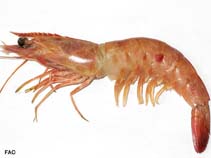Penaeus brasiliensis Latreille, 1817
Red spotted shrimp
Classification / Names Common names | Synonyms | CoL | ITIS | WoRMS
Malacostraca | Decapoda | Penaeidae
Environment: milieu / climate zone / depth range / distribution range Ecology
Benthic; depth range 0 - 500 m (Ref. 356), usually 45 - 65 m (Ref. 8). Tropical, preferred 27°C (Ref. 107945); 35°N - 35°S, 95°W - 34°W
Distribution Countries | FAO areas | Ecosystems | Occurrences | Introductions
Western Atlantic: From Cape Hatteras, USA, off Bermuda, Campeche and Yucatan, Mexico to West Indies and Rio Grande do Sul, Brazil.
Length at first maturity / Size / Weight / Age
Maturity: Lm ? range ? - ? cm Max length : 21.9 cm TL male/unsexed; (Ref. 85047); 26 cm TL (female)
Maximum standard length: 17.0 cm.
Life cycle and mating behavior Maturity | Reproduction | Spawning | Eggs | Fecundity | Larvae
Members of the order Decapoda are mostly gonochoric. Mating behavior: Precopulatory courtship ritual is common (through olfactory and tactile cues); usually indirect sperm transfer.
Main reference
References | Coordinator | Collaborators
Holthuis, L.B. 1980. (Ref. 8)
IUCN Red List Status (Ref. 130435: Version 2024-1)
CITES status (Ref. 108899)
Not Evaluated
CMS (Ref. 116361)
Not Evaluated
Threat to humans
Human uses
Fisheries: commercial
FAO - Fisheries: landings, species profile | FishSource | Sea Around Us
Tools
More information
Trophic Ecology
Food items
Diet
Food consumption
Ration
Predators
Diet
Food consumption
Ration
Predators
Ecology
Population dynamics
Life cycle
Human Related
Aquaculture profile
Stamps, Coins Misc.
Stamps, Coins Misc.
Outreach
Taxonomy
References
Internet sources
BHL | BOLD Systems | CISTI | DiscoverLife | FAO(Fisheries: species profile; publication : search) | Fishipedia | GenBank (genome, nucleotide) | GloBI | Gomexsi | Google Books | Google Scholar | Google | PubMed | Tree of Life | Wikipedia (Go, Search) | Zoological Record
Estimates based on models
Prior r = 0.39, 95% CL = 0.26 - 0.59, Based on 2 data-limited stock assessments.
Nutrients : Calcium = 109 [35, 184] mg/100g; Iron = 1.59 [1.21, 1.97] mg/100g; Protein = 20.2 [19.2, 21.3] %; Omega3 = 0.285 [0.185, 0.386] g/100g; Selenium = 48.3 [-31.7, 128.3] μg/100g; VitaminA = 0 μg/100g; Zinc = 1.79 [1.17, 2.40] mg/100g (wet weight); based on nutrient studies.



